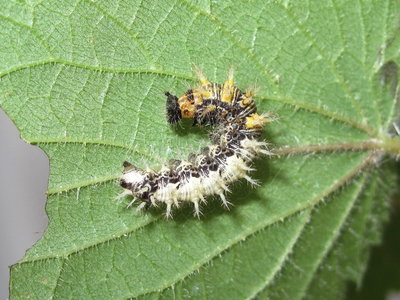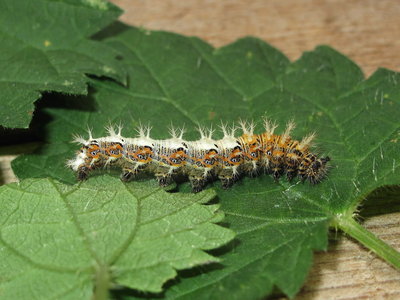Page 1 of 1
Larva id please
Posted: Sat Jul 29, 2017 3:27 pm
by peterc
Found a larva on and under a hazel leaf - thought it might have been of a Comma but I am not now so sure. It had been on this leaf for two days with apparently no more signs of feeding damage on the leaf. Can anyone help with the id please?
ATB
Peter
Re: Larva id please
Posted: Sat Jul 29, 2017 3:34 pm
by Padfield
It does look like a comma. It could be laying up for a skin change - this usually takes 2-4 days, depending on the weather. Larave often do this on leaves other than of their foodplant. If that is the case, try not to disturb it.
Guy
Re: Larva id please
Posted: Sat Jul 29, 2017 4:39 pm
by peterc
Thank you Guy.
The blue and gold colouring at the bottom end foxed me for a bit. Do you think it is currently in the third instar? By the way it is about 4 feet above ground if that makes any difference

.
I'll keep an eye on it.
ATB
Peter
Re: Larva id please
Posted: Sat Jul 29, 2017 5:38 pm
by Vince Massimo
Yes, definitely a Comma larva. The fact that it is on the wrong food plant and has not moved for a few days would suggest that it is preparing for a moult. The rusty coloration appears at the end of the penultimate instar. This would make it a 3rd instar larva (if it is a second brood individual) and soon to moult into the final 4th instar. However, I have some in my garden at the moment (on Nettle) and, despite the lateness of the season, they are first brood larvae, which go through 5 instars and so the colour appears in the 4th instar in that case.

- Comma larva (penultimate instar) - Crawley, Sussex 25-July-2017
Vince
Re: Larva id please
Posted: Sat Jul 29, 2017 6:14 pm
by peterc
Thank you, Vince.
Writing about the lateness of season made me think

.
The spot where the larva was found is part of my transect. The highest numbers of second brood (i.e.
hutchinsoni) adults were in week 13 and 14 (last week in June and first week in July) with 9 and 7 respectively. Some warm weather overall since then suggests that it is possible that the larva is now (unless it has already moulted since this morning) in the third instar from a
hutchinsoni brood.
ATB
Peter
Re: Larva id please
Posted: Mon Aug 07, 2017 7:06 am
by Mikhail
The larva may not be on the wrong food plant as suggested. Some of the continental literature mentions Hazel as a food plant,and I have myself seen the larva on Hazel in Slovenia. I have often wondered if Hazel is ever used in this country, so your find is of paerticular interest to me.
M.
Re: Larva id please
Posted: Mon Aug 07, 2017 10:03 am
by peterc
Thanks for your response and great to know that hazel is used as a foodplant elsewhere in Europe, Mikhail.
The larva is still on the hazel and I am 99% convinced that it had been feeding on the leaves due to typical lepidopteran leaf damage and lack of any significant apparent movement of the larva itself. It appears on or under the same leaf for two or more days. It should pupate, all being well, in the next day or two. I will write a fuller report with appropriate photographic evidence in due course.
Attached is a photo of it as of yesterday at around 2 pm.
ATB
Peter
Re: Larva id please
Posted: Mon Aug 07, 2017 11:03 am
by Vince Massimo
Interesting stuff Mikhail and Peter. I look forward to further updates on the progress of the larva. Mine typically pupated 10 days after the final moult.
Vince
Re: Larva id please
Posted: Mon Aug 07, 2017 12:27 pm
by bugboy
There's a little voice at the back of my head that keeps saying I've read somewhere that hazel is an occasional LHP for Commas. I'm gonna have to go through my books when I get home now as it's bugging me!
Re: Larva id please
Posted: Mon Aug 07, 2017 12:46 pm
by peterc
bugboy wrote:There's a little voice at the back of my head that keeps saying I've read somewhere that hazel is an occasional LHP for Commas. I'm gonna have to go through my books when I get home now as it's bugging me!
Well, Paul, try 'A Resource-based Habitat View for Conservation - Butterflies in the British landscape' by Roger L H Dennis published by Wiley-Blackwell in 2010 page 307 which lists Hazel
Corylus avellana as a hostplant but only used in captivity. Peter Hardy's database
http://pbh-butterflies.yolasite.com/1598.php includes it as a reference from 'Allan, P.M.B., 1949. Larval foodplants: a vade-mecum for the field lepidopterist'.
ATB
Peter
Re: Larva id please
Posted: Mon Aug 07, 2017 4:25 pm
by bugboy
peterc wrote:bugboy wrote:There's a little voice at the back of my head that keeps saying I've read somewhere that hazel is an occasional LHP for Commas. I'm gonna have to go through my books when I get home now as it's bugging me!
Well, Paul, try 'A Resource-based Habitat View for Conservation - Butterflies in the British landscape' by Roger L H Dennis published by Wiley-Blackwell in 2010 page 307 which lists Hazel
Corylus avellana as a hostplant but only used in captivity. Peter Hardy's database
http://pbh-butterflies.yolasite.com/1598.php includes it as a reference from 'Allan, P.M.B., 1949. Larval foodplants: a vade-mecum for the field lepidopterist'.
ATB
Peter
Thanks, I found the reference I was talking about (which looks like the same source):
Larval Foodplants, A Vade-Mecum for the field lepidoperist compiled by P. B. M. Allen published by Watkins and Doncaster
"In confinement will eat Goat Willow and Hazel"
I knew I read it somewhere

Re: Larva id please
Posted: Mon Aug 07, 2017 4:59 pm
by peterc
bugboy wrote:peterc wrote:bugboy wrote:There's a little voice at the back of my head that keeps saying I've read somewhere that hazel is an occasional LHP for Commas. I'm gonna have to go through my books when I get home now as it's bugging me!
Well, Paul, try 'A Resource-based Habitat View for Conservation - Butterflies in the British landscape' by Roger L H Dennis published by Wiley-Blackwell in 2010 page 307 which lists Hazel
Corylus avellana as a hostplant but only used in captivity. Peter Hardy's database
http://pbh-butterflies.yolasite.com/1598.php includes it as a reference from 'Allan, P.M.B., 1949. Larval foodplants: a vade-mecum for the field lepidopterist'.
ATB
Peter
Thanks, I found the reference I was talking about (which looks like the same source):
Larval Foodplants, A Vade-Mecum for the field lepidoperist compiled by P. B. M. Allen published by Watkins and Doncaster
"In confinement will eat Goat Willow and Hazel"
I knew I read it somewhere

Well done, Paul. Good to know what was written by P B M Allan regarding the Comma in his publication.
ATB
Peter
Re: Larva id please
Posted: Mon Aug 07, 2017 5:02 pm
by Pete Eeles
The Comma has quite a few food plants that are rarely mentioned! "Larval Foodplants of the Butterflies of Great Britain and Ireland" by Peter May (an AES publication), an excellent publication by an excellent chap, that lists Nettle, Hop, various willows, elms, Hazel, currants, Gooseberry and Pellitory of the Wall. Only the last is qualified as "in captivity" and so I assume that all other food plants have been witnessed in the wild.
Cheers,
- Pete
Re: Larva id please
Posted: Tue Aug 08, 2017 7:34 am
by peterc
Thanks, Pete. I have actually got that AES publication myself

.
Looking through all my several county guides there is one instance of a Comma larva on hazel in the wild. Ken WIllmott found one in Chiddingfold Forest in Surrey (no date given) referred to in the 'Butterflies of Surrey Revisited' book. Perhaps not as unusual as generally thought.
ATB
Peter
Re: Larva id please
Posted: Sun Aug 13, 2017 5:40 pm
by peterc
The Comma larva has now pupated so it appears it went through four stages, the last one (4th instar) lasting about 2 weeks. Is the colouring slightly different for 4th instar larvae raised from hutchinsoni adults?
ATB
Peter
Re: Larva id please
Posted: Sun Aug 13, 2017 7:13 pm
by Vince Massimo
Well done Peter for keeping track of the larva.
I have reared or monitored both broods of Comma larvae and found that they tend to have the same colouration. Only once have I encountered a pale larva, (in July 2013) but it gave rise to a normal adult.

- Comma larva (pale final instar) 23-July-2013
Vince
Re: Larva id please
Posted: Mon Aug 14, 2017 6:41 am
by peterc
Vince Massimo wrote:Well done Peter for keeping track of the larva.
I have reared or monitored both broods of Comma larvae and found that they tend to have the same colouration. Only once have I encountered a pale larva, (in July 2013) but it gave rise to a normal adult.
IMG_8480-01G.jpg
Vince
Thanks for the info, Vince. I will still keep an eye on it.
ATB
Peter
Re: Larva id please
Posted: Mon Aug 14, 2017 2:47 pm
by peterc
Sadly, the Comma pupa is no longer with us. It was in this state for up to 2 days only.
From what I have read, about 50% of pupae for British butterflies do not make it to adulthood. Perhaps mortality rates change for different broods. It is known that larvae raised from hutchinsoni Commas develop faster than normal but is pupal development quicker too and have an effect on the survival rate of the pupae?
ATB
Peter
Re: Larva id please
Posted: Sat Aug 19, 2017 12:34 pm
by peterc
I walked my Stevenage transect this morning in mostly cloudy conditions and therefore few butterflies but I had a big smile on my face by the end of it

. I had a cursory look at the hazel shrub where I previously discovered a Comma larva which successfully pupated. I was just looking for the leaf formations like the 'tents' created by the larva earlier in the month. I didn't find any such structures but what did I find? Another Comma pupa (correct me if I am wrong) but this time at eye-level - I really thought it was a wrinkled leaf at first. Perhaps being higher up is a more successful strategy for avoiding being predated by ground mammals (for instance). The first Comma pupa was much darker so I am wondering if the general colouring changes as the pupae develop? It does add another twist to the story. Besides it would be a lot easier finding these pupae on hazel than among the nettles

.
ATB
Peter